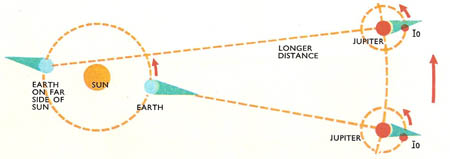 Rømer's determination of the speed of light was the demonstration in 1676 that light has a finite speed, and so doesn't travel instantaneously. The discovery is usually attributed to Danish astronomer Ole Rømer (1644–1710), who was working at the Royal Observatory in Paris at the time. By timing the eclipses of the Jupiter moon Io, Rømer estimated that light would take about 22 minutes to travel a distance equal to the diameter of Earth's orbit around the Sun.
Rømer's determination of the speed of light was the demonstration in 1676 that light has a finite speed, and so doesn't travel instantaneously. The discovery is usually attributed to Danish astronomer Ole Rømer (1644–1710), who was working at the Royal Observatory in Paris at the time. By timing the eclipses of the Jupiter moon Io, Rømer estimated that light would take about 22 minutes to travel a distance equal to the diameter of Earth's orbit around the Sun. This would give light a velocity of about 220,000 kilometres per second in SI units, about 26% lower than the true value. Rømer's theory was controversial at the time he announced it, and he never convinced the director of the Royal Observatory, Giovanni Domenico Cassini, to fully accept it. However, it quickly gained support among other natural philosophers of the period, such as Christiaan Huygens and Isaac Newton. It was finally confirmed nearly two decades after Rømer's death, with the explanation in 1729 of stellar aberration by the English astronomer James Bradley.
Several discussions have suggested that Rømer should not be credited with the measurement of the speed of light, as he never gave a value in Earth-based units. These authors credit Huygens with the first calculation of the speed of light. Huygens's estimate was a value of 110,000,000 toises per second: as the toise was later determined to be just under two metres,[note 10] this gives the value in SI units. However, Huygens's estimate was not a precise calculation but rather an illustration at an order of magnitude level. The relevant passage from Treatise sur la lumière reads: